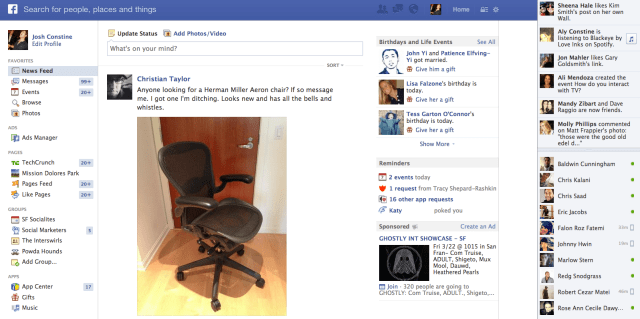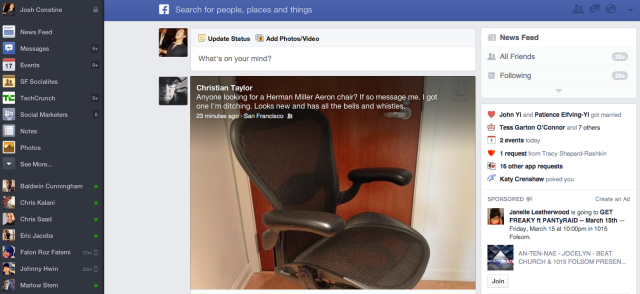“Fortune Favors The Bold” reads a 20-foot-tall poster in the room where Facebook unveiled its redesigned news feed. It’s possibly the most looked-at page on the Internet, and if we don’t like the changes, traffic and ad revenue could plummet. Despite a slow rollout where it will watch for our reactions and make tweaks, Facebook’s never put it all on the line like this.
Panicked erupted when Facebook first overhauled its homepage with the launch of the news feed in 2006. But in the end, Facebook won that bet. We all realized the feed didn’t violate our privacy. It just collected what we could already see on Facebook, and we discovered that constant stream of information was highly addictive. Time-on-site shot up and the social network grew into the powerhouse we know today.
Out With The Old

Now Facebook’s trying to pull off that feat again, but the stakes are much higher. It’s got 1 billion users, thousands of third-party businesses depending on it, fickle advertisers, and Wall Street nagging it to make more money. Luckily it’s learned a lot in the last seven years. It doesn’t shock and awe us with simultaneous product changes. A system called Gatekeeper lets it roll out new features to tiny fractions of its user base so it can bug test and gauge reactions before pushing further.
Still, the news feed redesign isn’t like Open Graph, Timeline or Graph Search. Those are comparatively niche products. Mark Zuckerberg and his squad can experiment all they want with apps like Poke or money-makers like Gifts, but it’s the news feed where we actually spend our time on Facebook. It’s the homepage, the main screen of its mobile apps, and the reason we come back so many times a day.
The flap of a butterfly’s wings on the feed’s design spins tornadoes through our ingrained behaviors. Humans are inherently averse to change, and, good or bad, we grumble. Facebook doesn’t care. Or, more accurately, it’s okay ruffling a few feathers if it thinks it knows better than we do. The original news feed launch was grand proof of that. One of its early privacy scandals, Beacon, turned out to be just a little too far ahead of its time. Years later practically the same feature emerged as Open Graph frictionless sharing, and people accepted it.
Are We In For The New?

It was time for a shake-up. As Ryan Tate of Wired recounts, Mark Zuckerberg explained “As what we all share changes, the composition of News Feed should change as well…. We want updates from our friends but also from publications and businesses we care about, so this is the evolving face of News Feed.”
Facebook saw attention slipping away to more visual feeds like Instagram, and Twitter getting more serious about media with its embedded cards. Mobile-first design threatened to make Facebook’s website, and its apps that are modeled after it look dated. Meanwhile Facebook wanted to drastically increase the amount of time we spend on the service not only to get us sharing more, but also to show us more ads that are now more vivid, as Rebecca Greenfield details for The Atlantic Wire. That meant changing the news feed.
Just as I wrote on Tuesday, this morning Facebook revealed a visual overhaul, bigger pictures, and extra feeds. For some of us, it may be a bit overwhelming. Suddenly, Facebook isn’t such a linear experience. We have to decide what to view. If the update works as Facebook planned, that added choice will make us feel like the masters of our social networking destiny.
The danger is that it’s too complicated. Remember that Facebook is a global utility that reaches a lot of people without a solid education or a ton of tech literacy. Many already complained the site was too confusing. The redesign only exacerbates that problem. If users get frazzled or find news feed navigation too mentally taxing, they may visit and scroll less.
Facebook will be closely monitoring to see if that happens. VP of Product Chris Cox said the roll out will be “slow” and “cautious” over the next few weeks, and tweaks will be made where necessary. The big press event today mean it can’t just scrap the whole thing if it bombs, though. Whether the world wants it or not, whether we use Facebook more or less because of it, the new news feed is coming.
But standing still wasn’t an option. It’s Facebook’s willingness to tinker that sets it apart from previous tech giants whose power has faded. Nimble startups are a huge threat to sluggish corporations, yet Facebook seems dead set on continuing to “move fast and break things” even now that it’s a public company.
Facebook turned nine this year, but that won’t stop it from trying to live out classic rocker Tom Petty’s old quote: “You never slow down, you never grow old.” Now we’ll see if users bail out, or come along for the ride.
Read more:
Facebook Launches Feeds For Photos, Music, Friends-Only, And More
Hands-On With The New Facebook And Its Boredom-Killing Feeds [TCTV]
For Businesses, Facebook’s Redesign Means Bigger Ads, A Pages Feed, But A Friends-Only Section Too
Facebook’s Focus On Mobile-Inspired Consistency Is All About Getting Facebook “Out Of The Way”